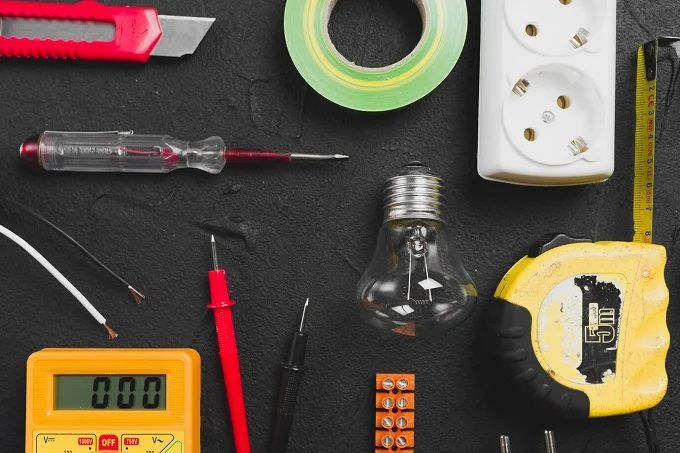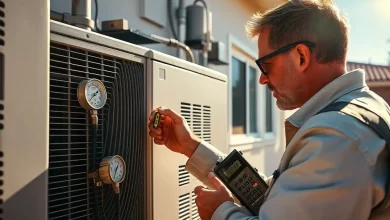Essential Electrician’s Toolkit

Electricians rely on diverse specialized tools to perform their work safely and efficiently. From wire strippers and voltage testers to insulated pliers and multimeters, a well-equipped toolkit is essential for tackling the various challenges encountered in electrical installations and repairs.
Essential Electrician’s Tools
Electricians require a diverse set of specialized tools to perform their work safely and effectively. Here’s a list of essential tools that every electrician should have in their toolkit:
- Wire Strippers: Used to remove insulation from electrical wires without damaging the conductor.
- Insulated Screwdrivers: Come in various types including slotted, Phillips, and Pozidriv, with insulated handles for safety.
- Pliers: Essential for gripping, twisting, and cutting wires. Types include lineman’s pliers, needle-nose pliers, and side-cutting pliers.
- Voltage Tester: Non-contact testers detect the presence of voltage without direct contact.
- Multimeter: Measures voltage, current, and resistance in electrical circuits.
- Fish Tape: Used to route wires through walls and conduits.
- Cable Cutters: Designed for cutting thick electrical cables.
- Electrician’s Knife: For stripping larger wires and cables.
- Hacksaw: Used for cutting conduit and other materials.
- Level: Ensures proper alignment of electrical boxes and fixtures.
- Tape Measure: For accurate measurements during installations.
- Torch: Provides illumination in dark work areas.
- Chisel: Useful for creating channels in walls for wiring.
- Insulated Hand Tools: VDE-certified tools with insulated handles for protection against electric shock.
- Wire Crimpers: Used for attaching connectors to wires.
- Electrician’s Staple Gun: For securing cables during installations.
- Electrical Tape: Used for insulating wire connections.
- Hex Keys: For tightening or loosening hex-socket screws.
- Safety Knife: For various cutting tasks.
This comprehensive set of tools enables electricians to handle a wide range of electrical tasks safely and efficiently.
Specialized Electrician Equipment
Electricians rely on a wide array of specialized tools to perform their work safely and efficiently. Here’s an in-depth look at some of the other essential tools in an electrician’s arsenal:
- Wire Crimpers: Used to attach connectors to wires securely. They compress the connector around the wire, creating a strong electrical and mechanical connection. Different types of crimpers are available for various connector sizes and styles.
- Fish Tape: A flexible, thin steel tape used to route wires through walls, conduits, and other enclosed spaces. It’s typically wound on a reel and can be pushed or pulled through cavities to guide wires.
- Conduit Benders: Essential for bending electrical conduit to specific angles, allowing for neat and professional installations. They come in various sizes to accommodate different conduit diameters.
- Cable Rippers: Also known as cable strippers, these tools are designed to quickly and safely remove the outer sheathing of electrical cables, exposing the inner wires.
- Knockout Punches: Used to create precise holes in electrical boxes and panels for conduit entry. They come in various sizes and can be manual or hydraulic.
- Reciprocating Saw: A versatile power tool useful for cutting through various materials, including wood and metal, during electrical installations.
- Stud Finder: Helps locate wall studs for secure mounting of electrical boxes and fixtures.
- Wire Pulling Lubricant: A specialized gel or spray used to reduce friction when pulling wires through conduits, making the process easier and preventing damage to wire insulation.
- Insulation Resistance Tester (Megger): This advanced tool is used to test the integrity of electrical insulation in wires, cables, and equipment.
- Circuit Breaker Finder: Helps identify which circuit breaker controls a specific outlet or fixture, saving time during troubleshooting and repairs.
- Electrical Tape: Available in various colors for color-coding and insulating wire connections. High-quality electrical tape provides excellent insulation and durability.
- Cable Ties: Used for bundling and organizing wires and cables neatly.
- Hole Saws: Circular cutting tools attached to a drill for creating precise holes in various materials for electrical installations.
- Thermal Imaging Camera: While not a standard tool for all electricians, these devices are increasingly used to detect overheating in electrical systems and identify potential issues before they become serious problems.
- Voltage Indicator: A simple tool that lights up when in contact with a live wire, providing a quick way to verify if a circuit is energized.
- Wire and Cable Testers: Devices that test continuity, polarity, and other characteristics of electrical circuits and network cables.
- Electrician’s Scissors: Specially designed scissors with serrated blades for cutting through various types of electrical wires and cables.
This diverse set of tools allows electricians to handle a wide range of tasks, from installation and repair to testing and troubleshooting, ensuring safe and efficient electrical work.
Non-Contact Voltage Testers
Non-contact voltage testers, also known as voltage detectors or voltfinders, are essential safety tools for electricians. These handheld devices can detect the presence of AC voltage without direct contact, typically in the range of 90 to 1000 volts AC. They work by sensing small capacitively coupled currents from live circuits. When voltage is detected, the tester alerts the user through visual indicators like LED lights and/or audible tones.
Non-contact voltage testers are particularly useful for quickly checking if wires or outlets are energized, tracing live circuits, and differentiating between live and neutral wires. While not as comprehensive as multimeters, these testers provide a fast, safe way to verify the presence of voltage before beginning work on electrical systems.
Electrician’s Staple Gun
The electrician’s staple gun, such as the DeWalt DCN701D2 XR Electricians Stapler, is a specialized cordless tool designed to secure cables quickly and consistently during electrical installations. This 18V battery-powered device eliminates the need for hoses or cables, allowing for greater mobility on job sites.
It features an automatic depth adjustment based on cable thickness, ensuring staples fit snugly without pinching the wires. With a compact size of 200mm, it can easily fit between joists and in confined spaces. The stapler typically has a magazine capacity of 35 staples and can accommodate staple lengths of around 25.4mm. Additional features often include a built-in LED light for improved visibility in dark areas, an integrated cable guide for easy alignment, and a belt hook for convenience. These staple guns significantly increase productivity compared to traditional manual cable-fixing methods.
Ratchet Cable Cutting Tools
Electrical ratchet cable cutters are specialized tools designed for effortlessly cutting through thick copper and aluminum cables. These hand-held devices feature a ratcheting mechanism that provides increased leverage, allowing electricians to cut cables up to 400mm in diameter with reduced physical effort. The ratchet action enables a two-stage cutting process, which enhances energy efficiency and makes the tool easier to use in confined spaces.
Many models, such as the RCC32-AR, are specifically designed for armored cables up to 32mm in diameter. These cutters typically feature ergonomic handles for improved grip and comfort during use, and their lightweight design contributes to reduced user fatigue during prolonged cutting tasks.
Quality Tool Investment
When buying professional tools for electrical work, it’s crucial to invest in high-quality, durable equipment that meets safety standards and enhances productivity. Here are some key considerations for purchasing professional electrician tools:
- VDE Certification: Look for tools with VDE (Verband Deutscher Elektrotechniker) certification, which ensures they meet safety standards for working with live electrical systems. VDE-certified tools are insulated and tested to withstand voltages up to 1000V AC.
- Brand Reputation: Opt for well-known brands with a track record of producing reliable tools for electricians. Reputable brands include Knipex, Wera, Bahco, and DeWalt.
- Insulation: Ensure that hand tools like screwdrivers and pliers have proper insulation to protect against electric shock. Look for tools with multi-layered insulation for added safety.
- Durability: Professional-grade tools should be made from high-quality materials that can withstand frequent use and harsh job site conditions. For example, tools with hardened steel blades or tips offer better longevity.
- Ergonomics: Choose tools with ergonomic designs to reduce hand fatigue and improve comfort during extended use. Features like cushioned grips can make a significant difference in daily work.
- Versatility: Consider multi-functional tools that can perform various tasks, reducing the number of tools you need to carry. For instance, some pliers combine wire stripping and cutting functions.
- Compliance with Industry Standards: Ensure that measuring and testing equipment, such as multimeters, comply with relevant safety standards like CAT III or CAT IV ratings for electrical work.
- Tool Kits: For new electricians or those looking to upgrade their entire toolkit, consider purchasing comprehensive electrician tool kits. These often provide better value and ensure compatibility between tools.
- Warranty: Check the warranty offered by manufacturers, as longer warranties often indicate higher quality and durability.
- Storage Solutions: Invest in a good-quality tool bag or case to organize and protect your tools. Some options, like the CK Magma Wheeled Toolcase, offer features like extra-wide compartments with red lining for high tool visibility and all-terrain wheels for easy transport.
- Regular Upgrades: Stay informed about new tool technologies and be prepared to upgrade your equipment as newer, more efficient options become available.
- Cost vs. Quality: While professional-grade tools may be more expensive initially, they often prove more cost-effective in the long run due to their durability and performance. Balance cost with quality when making purchasing decisions.
By considering these factors, electricians can build a toolkit that not only meets safety requirements but also enhances their efficiency and productivity on the job.
Safety Precautions and Best Practices
Electrical safety is paramount when working with electricity. Key precautions include always
assuming circuits are live until proven otherwise, using proper personal protective equipment (PPE) like insulated gloves and safety shoes, and following lockout/tagout procedures when servicing equipment. It’s crucial to keep the work area dry, avoid using damaged tools or equipment, and maintain a safe distance from live electrical parts.
Proper insulation and grounding of tools and equipment is essential. When working at heights, use non-conductive ladders and stay at least 10 feet away from overhead power lines. Regular safety checks, proper cable maintenance, and avoiding flammable materials near electrical equipment are also vital practices. For complex tasks or high-voltage work, only qualified personnel should be involved. By adhering to these safety measures, electrical workers can significantly reduce the risk of accidents and injuries.
Ergonomic Design Considerations
Ergonomic design is crucial for electricians’ tools to reduce fatigue, prevent injuries, and improve overall efficiency. Key considerations include selecting tools with padded grips and handles that extend along the entire palm to reduce contact pressure. Handles should be made of slip-resistant materials like plastic or rubber and sized appropriately for the user’s hand.
For repetitive tasks, powered or ratcheting tools with variable speed and torque limiters are recommended. Spring-loaded pliers and crimpers can reduce grip force requirements. Tool orientation is also important – inline tools work best for horizontal surfaces, while pistol grips are suited for vertical work.
Electricians should use torque bars on heavy tools like pipe threaders to minimize effort, and opt for power tools with longer triggers to accommodate multiple fingers. Proper tool maintenance and using reduced-vibration tools can further enhance ergonomics. Additionally, electricians should consider using stools or kneepads when working in low areas to reduce strain from crouching or kneeling.
General Construction Safety Gear
Construction workers require a range of personal protective equipment (PPE) and general tools to ensure their safety and efficiency on the job site. Here are some essential items:
- Hard Hat: A crucial piece of safety equipment that protects against falling objects and head injuries. Hard hats should be made of high-density polyethylene and may include features like noise-canceling, face shields, or even radios.
- High-Visibility Clothing: Reflective vests or jackets are essential for ensuring workers are visible, especially in low-light conditions or around moving vehicles and machinery.
- Safety Footwear: Steel-toed boots or shoes that are slip-resistant and puncture-proof are vital for protecting feet from falling objects and providing stability on various surfaces.
- Safety Glasses: Eye protection is crucial to guard against debris, dust, and potential chemical splashes.
- Gloves: Different types of gloves may be needed depending on the task, such as cut-resistant gloves for handling sharp materials or insulated gloves for electrical work.
- Hearing Protection: Earplugs or earmuffs are necessary in noisy environments to prevent hearing damage.
- Respiratory Protection: Dust masks or respirators are essential when working with materials that produce harmful fumes or particles.
- Knee Pads: These protect the knees during tasks that require kneeling for extended periods.
- Fall Protection Equipment: For work at heights, safety harnesses and lanyards are crucial.
- First Aid Kit: A well-stocked first aid kit should be readily available on all construction sites.
- Fire Blanket: This can be crucial for quickly extinguishing small fires or wrapping around a person whose clothes have caught fire.
- Safety Signs: While not personal equipment, proper signage is essential for communicating hazards and safety protocols on the site.
- Sunscreen and UV-Protective Clothing: Protecting against sun exposure is important for outdoor work.
- Hydration Pack: Staying hydrated is crucial, especially in hot weather conditions.
- Tool Belt or Vest: This allows workers to keep necessary tools close at hand, improving efficiency and reducing the risk of dropping tools from heights.
Construction sites can significantly reduce the risk of injuries and create a safer work environment by ensuring that workers have access to and properly use these tools and PPE. It’s important to note that specific PPE requirements may vary depending on the nature of the work and local regulations.



